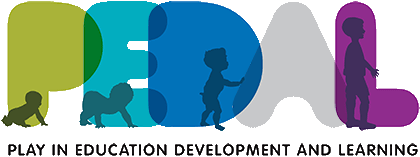Role play allows children to “play out” unfamiliar scenarios
Starting around age three, children’s play tends to become much more imaginative. They might use dolls, toys, or everyday household objects to create pretend worlds ready for exploration. Sometimes the play can be rather fantastical – driving through a jungle filled with wild animals or transforming into superheroes battling to save the world. Other times, role playing can mimic aspects of reality for a child to “play out” scenarios on their own terms, such as tea parties with stuffed animals, schools and teachers, or playing doctor. This type of play is a natural and entertaining way for children to delve into or practice situations they might encounter in everyday life in a safe, controlled space.
At a young age, going to the doctor’s surgery can be an unnerving experience; however, as it is a semi-regular, expected occurrence for so many children, there are plenty of resources to help them through those visits. Children’s books and shows will have characters visiting the doctor when they feel ill, and small medical kits with stethoscopes and thermometers are a very common toy for children to pretend-play “doctor.” Unlike with a visit to the doctor though, a child needing to go to hospital either for themselves or a family member is not (intuitively) quite so simple to explore playfully. Often children go to hospital unexpectedly, in high-stress situations, and arrive in an environment that can either be quiet and sterile or loud and chaotic, but always full of (mostly adult) strangers. Of those children that are around, many are patients too, perhaps unwell or in distress, which can heighten children’s sense of anxiety. Unfamiliar medical tools, such as blood pressure monitors, X-rays and cannulas, can seem scary or potentially painful. Importantly, negative early experiences of hospitals can have a long-lasting impact on how children feel about, and engage with, healthcare environments into their futures.
Teddy Bear Hospital: Understanding hospital visits through play
How can we help children engage in that same playful behaviour around hospital experiences that helps them explore regular visits to the doctor? This is the aim behind Teddy Bear Hospitals – a public health program for children around ages 3-8 to address the anxieties and fears that children might associate with going to hospital. Teddy Bear Hospitals are implemented in various places around the world, including the UK, Norway, Germany, Singapore, Israel, Australia, the United States, and more. While there are often play opportunities within a hospital for children who are existing patients, Teddy Bear Hospitals are geared toward children from local schools and communities to provide a playful opportunity to learn and understand many of the things that may occur within a hospital, without being active patients themselves. Children are able to explore the environment, equipment, and jargon of the hospital through a simulated experience catered toward them – and their teddy bears.
Through school trips or community open days, children visit Teddy Bear Hospitals at or near their local hospital – close enough to experience the environment but away from any potential real medical situations. Children are instructed to play the role of their teddy’s caregiver, and upon arrival they tell the Teddy Bear Doctors (medical students) what ailment or complaint brought their teddy to the hospital. Child and teddy then go along to various stations that simulate things that occur at real hospital visits. As their teddies receive treatment, the children are encouraged to engage with the spaces and equipment used to provide medical care and actively participate in their “role” as their teddy’s guardian. They are able to see how and why things occur within the hospital and play their way through different medical situations.
Teddy Bear Hospital stations include:
- Consultation – Children take a history and examine teddy using stethoscopes and blood pressure cuffs on themselves and teddy. Together, children and Teddy Bear Doctors make a diagnosis.
- Ambulance – Children learn why and how to call 999. They see inside an ambulance, hear the loud noises, explore the equipment, and keep the beat of CPR through song.
- Accident and Emergency – Children “take blood” and give injections to teddy with needle-free syringes.
- Radiology – See teddy X-rays and talk about bones and organs in the body.
- Plaster – Casting teddy’s arm or leg and decorating the plaster – messy play!
- Surgery – Children dress up in scrubs, and learn about hand hygiene and anaesthesia. One special teddy has a zipper opening and children can see stuffed toy versions of the heart, stomach, appendix, etc.
- Ward – Complete an “intake” form and do a teddy bear check-up using thermometers, weighing scales, peak flow metres, etc.
- Pharmacy – Discuss common painkillers (empty packets and containers) and inhalers. Discharge teddy with a prescription for ice bags, plasters, and, importantly, love and snuggling.
- Healthy living – Including nutrition, hygiene, and exercise.
Childhood in hospital: Play is essential
The rise and recognition of play as an essential feature of children’s overall wellbeing has critically improved conceptualisations around paediatric hospital care. Play experiences within a hospital provide young patients with age-appropriate ways to make sense of illness and medical procedures. Such opportunities for play allow patients to be children and find a semblance of regular childhood in an otherwise atypical setting. To that end, many Teddy Bear Hospitals include additional stations for general play – emphasising ways of getting exercise, drawing and music stations to highlight various forms of art therapy, and also providing a basic opportunity for children to express and process the experiences of the Teddy Bear Hospital.
With an ever-increasing understanding about how and why play occurs in medical environments, simulating a playroom as a separate part of the Teddy Bear Hospital ward station could be meaningful as children are learning and exploring what it would be like to go to hospital. Such a station could include art therapies as well as the different types of playful activities, crafts, and games that are available while undergoing a hospital stay. This would emphasise that even whilst undergoing medical care, there can be opportunities for play to be a part of a child’s hospital experience. Integrating play, alongside the medicine, into the fabric of paediatric hospital care encourages children to see themselves as accepted and welcome in that space, one catering to their developmental needs and rights as children.
Research has shown real impact from these programs: engaging in Teddy Bear Hospitals helps to reduce anxiety associated with healthcare and enhances children’s knowledge of the body, health and illness, and medical procedures. Teddy Bear Hospitals are a phenomenal resource for children at an age where they are full of imagination and wonder. The chance to explore what can be an intimidating medical setting in a safe, simulated environment through play may have far reaching implications for children, empowering them to understand and engage with their future healthcare.
You can find more information on the Teddy Bear Hospitals at the University of Cambridge here.
Thanks to Jenny Whitby (University of Cambridge School of Clinical Medicine), President of Teddy Bear Hospital 2019-2020, for her support and collaboration in writing this piece.

Relevant articles
- Does the ‘Teddy Bear Hospital’ enhance preschool children’s knowledge? (Leonhardt et al., 2014)
- Healthcare encounters in young children: Impact of Teddy Bear Hospital, Singapore (Lynn et al., 2018)
- Training new doctors through child’s play (Monagle, 2019)
- Teddy Bear Hospital: Where clinical gets cuddly (Thambapillai, 2019)

Kelsey Graber
University of Cambridge PhD Student

